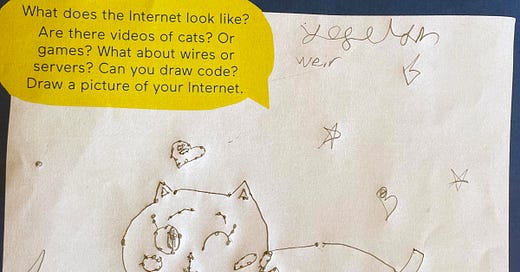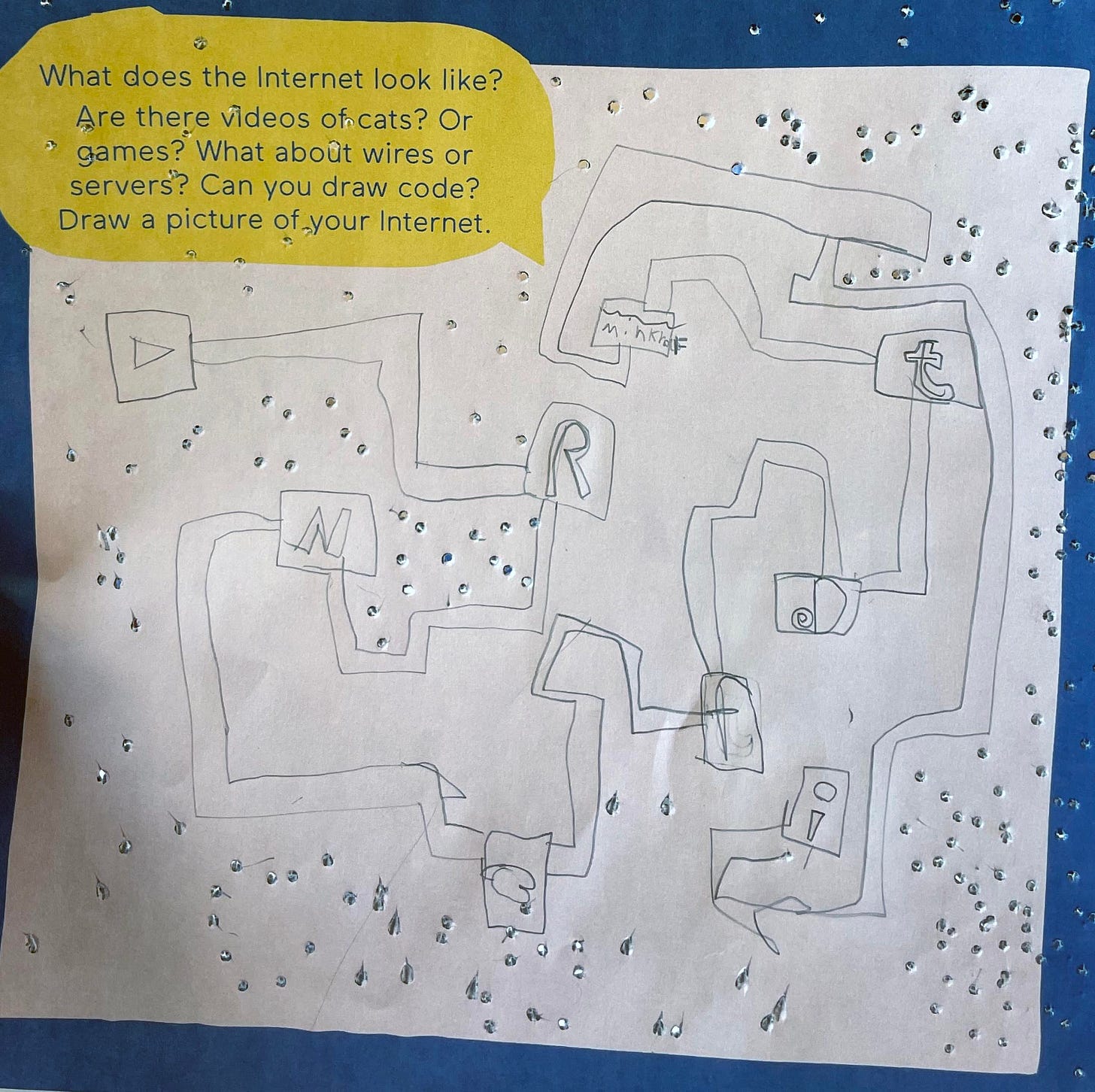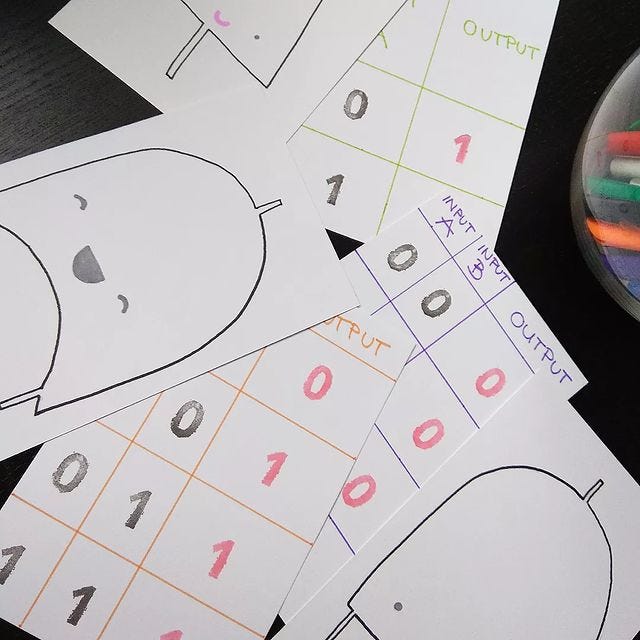My name is Linda. I write a bi-weekly newsletter about computer science, childhood and culture - and there are 9 598 of you listening. If you enjoy this issue, please share it with anyone you think may find it useful.
A few weeks back I visited several public schools in Winchester, Virginia, invited by the lovely METRICS team. During the two days we did several workshops for students, educators and the general public. I loved the work. There is a lot to unpack of the visit, but especially one event stuck with me.
The task we ran with a mixed group of 100+ first and second graders is one I like doing a lot. After listening to the story of Ruby and her friends building a snow Internet, the children are asked to imagine themselves what the Internet looks like.
Surprising things always happen.
One of the children was drawing on the floor, which was covered with a soft, thick carpet. The sharp pencil kept poking holes to the drawing. Instead of getting discouraged or annoyed the child decided to build the drawing around these holes. The nearby children noticed this and started incorporating the idea into their drawings as well. In a matter of minutes we had a a room full of perforated paper sheets.
In some pedagogical realm this would have been a ruined exercises. How do you teach about servers, protocols and Internet safety with a class full of vigorously pen punching children?
But in some other way, the children captured the essence of Internet.
Internet is made of light, because the Internet includes things like fiber optic cables and pulses of light travelling across vaste distances. In a looser sense, Internet is also energy moving through matter. Holding the drawings against the light I could see this, and so could the kids.
Pre-defined curriculum and learning goals don’t capture this moment. I’m reminded of a passage by Vea Vecchi in Art and Creativity in Reggio Emilia: “It is important to society that schools and we as teachers are clearly aware of how much space we leave children for original thinking, without rushing to restrict it with predetermined schemes that define what is correct according to a school culture. How much do we support children to have ideas different from those of other people and how do we accustom them to arguing and discussing their ideas with their classmates?”
The children also learned something about networks and how ideas spread and how ownership is porous. Building on top of this experience I believe a much more nuanced learning can take place. This could be a warm-up activity for a larger art project, where materials and metaphors are discussed with more time. Or maybe the next step is exploring the similarities and differences of the hundred drawings, grouping them together and finding language to describe the different aspects of Internet discovered.
I was also impressed by the educators ability to notice and listen. Loris Malaguzzi called educators ‘professional marvellers’ and even in this short, 45 minute session we were surprised and delighted by theories of children, even if they were not correct in the traditional sense of the word. From the same book: “It is no coincidence that Jerome Bruner recalls that what struck him most on first entering the Reggio schools was a teacher who was listening to a child’s theories on how shadows are formed. He emphasizes how this listener was interested and serious, because the child was putting together a theory the credibility of which was not important. What was important was the process that led to the construction of the theory.”
Linked List
In computer science, a linked list is a linear collection of data elements whose order is not given by their physical placement in memory. But here it is a selection of things I’ve been reading lately.
Every time I’m professionally lost, I return to the writings from Reggio Children. I haven’t written nearly enough about the ideas of Reggio and their influence on me, but here’s two old letters: On Drawing as a Language and But to see like this
Reggio Children offers a lot of wonderful entry points into their philosophy. In the beginning the meandering and very philosophical style of describing the approach frustrated me, but now it is probably my favorite thing about the philosophy. Depending on your, they have online meeting groups, pre-recorded webinars, books, and even the physical visits to the center are back. I took one class and it was a highlight of the pandemic time.
Reggio Children has made available also free materials called At Home with The Reggio Approach. Try for example the Trees are Family prompt to get started.
Classroom
I’m hoping to surface and share stories from all of you and I’d love to see your creations! Here are a few teachers using Ruby in creative, fun and inspiring ways.
In addition to this weeks highlights, I wanted to ask (almost whisper?) if there are any educators who would be curious to form a sort of sub committee around this newsletter? Just this spring, I’ve worked with or seen work by amazing educators from US, Spain, Taiwan, Australia, Czech and a bunch of other places. I wonder if there was a way to put us all together in some more structured way? If you’re interested in being a part of this pilot program, drop a note here.
This is such a heartwarming activity not only for the laminated map, but also the act of making a real version of the raft of penguins (you’ll need to click through the carousel.)


One of my favorite things to do with the series is to hide little easter eggs in the pictures. It’s so rewarding to have people discover them years after, this one from Expedition Internet.
I love how logic gates, which often seem inapproachable and remote, turn into something friendly and fun in this riff on the second Ruby book, Journey Inside the Computer.









"He emphasizes how this listener was interested and serious, because the child was putting together a theory the credibility of which was not important. What was important was the process that led to the construction of the theory.”
It makes me emotional reading stories like these--seeing the dignity and wonder in children's ideas. I think this picture of attentiveness towards children is something I longed for as a kid.